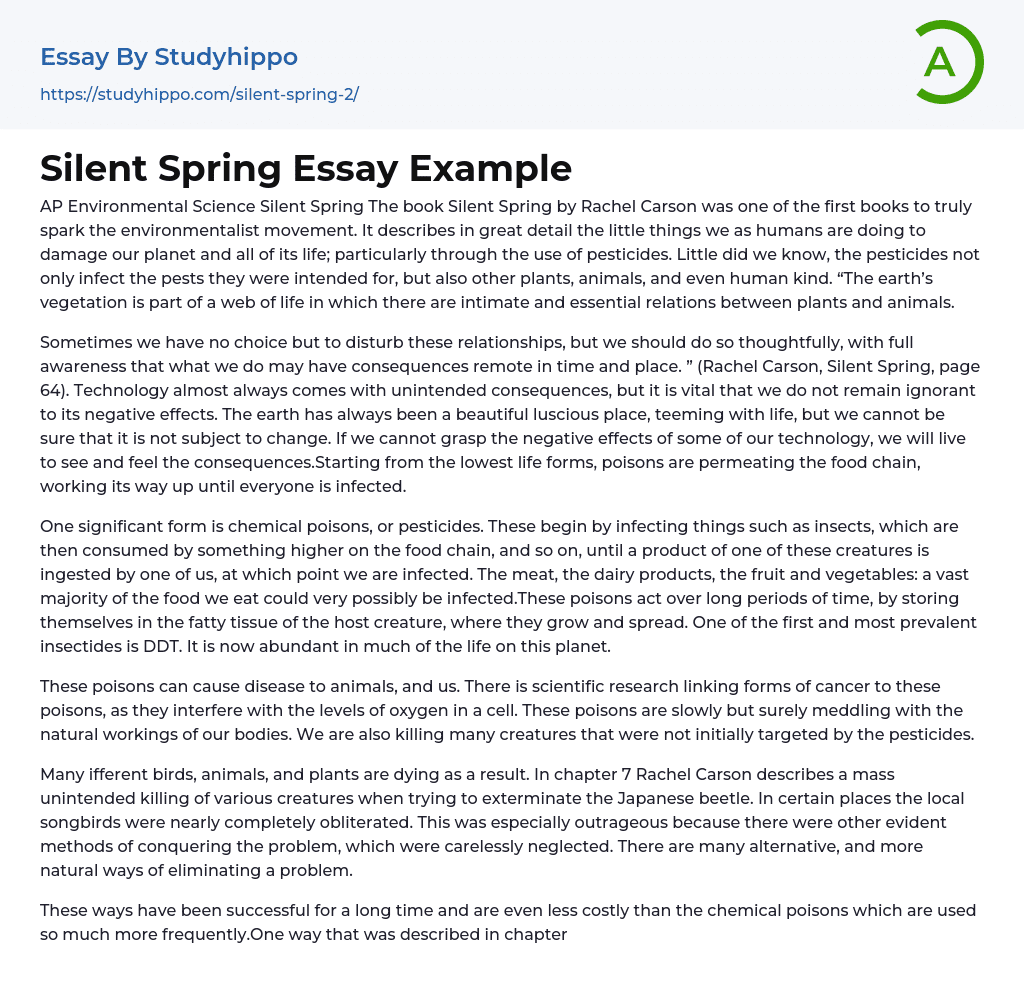AP Environmental Science Silent Spring The book Silent Spring by Rachel Carson was one of the first books to truly spark the environmentalist movement. It describes in great detail the little things we as humans are doing to damage our planet and all of its life; particularly through the use of pesticides. Little did we know, the pesticides not only infect the pests they were intended for, but also other plants, animals, and even human kind. “The earth’s vegetation is part of a web of life in which there are intimate and essential relations between plants and animals.
Sometimes we have no choice but to disturb these relationships, but we should do so thoughtfully, with full awareness that what we do may have consequences remote in time and place. ” (Rachel Carson, Silent Spring, page 64).
...Technology almost always comes with unintended consequences, but it is vital that we do not remain ignorant to its negative effects. The earth has always been a beautiful luscious place, teeming with life, but we cannot be sure that it is not subject to change. If we cannot grasp the negative effects of some of our technology, we will live to see and feel the consequences.Starting from the lowest life forms, poisons are permeating the food chain, working its way up until everyone is infected.
One significant form is chemical poisons, or pesticides. These begin by infecting things such as insects, which are then consumed by something higher on the food chain, and so on, until a product of one of these creatures is ingested by one of us, at which point we are infected. The meat, the dairy products
the fruit and vegetables: a vast majority of the food we eat could very possibly be infected.These poisons act over long periods of time, by storing themselves in the fatty tissue of the host creature, where they grow and spread. One of the first and most prevalent insectides is DDT. It is now abundant in much of the life on this planet.
These poisons can cause disease to animals, and us. There is scientific research linking forms of cancer to these poisons, as they interfere with the levels of oxygen in a cell. These poisons are slowly but surely meddling with the natural workings of our bodies. We are also killing many creatures that were not initially targeted by the pesticides.
Many ifferent birds, animals, and plants are dying as a result. In chapter 7 Rachel Carson describes a mass unintended killing of various creatures when trying to exterminate the Japanese beetle. In certain places the local songbirds were nearly completely obliterated. This was especially outrageous because there were other evident methods of conquering the problem, which were carelessly neglected. There are many alternative, and more natural ways of eliminating a problem.
These ways have been successful for a long time and are even less costly than the chemical poisons which are used so much more frequently.One way that was described in chapter 17 that has proven extremely successful is to tamper with the biology of a specific insect or pest. These controls get the job done, and are harmless to the environment. There are also methods of sterilizing them so that the problem that they pose is eliminated. All of that put aside, insects
are becoming resistant to some of these chemicals, making them truly useless. At that point, they are not even doing their intended purpose, and only harming other things.
This issue is more urgent than we ever expected.These chemicals are in the water we drink, the food we eat, the sights we see, and growing in our bodies everyday. For all time we have been able to look out on our earth and marvel at the natural beauty. Those first signs of spring: the blossoming flowers, the bird’s songs, the budding trees, could eventually be lost. Unless we act, we could destroy the oldest and most natural gift of all. Since the writing of Silent Spring many people have taken the initiative and made an effort to help the environment, but there is much still left to do.
It is more necessary than we can even comprehend.
- Microbiology essays
- Bacteria essays
- Cell essays
- Enzyme essays
- Photosynthesis essays
- Plant essays
- Natural Selection essays
- Protein essays
- Viruses essays
- Cell Membrane essays
- Human essays
- Stem Cell essays
- Breeding essays
- Biotechnology essays
- Cystic Fibrosis essays
- Tree essays
- Seed essays
- Coronavirus essays
- Zika Virus essays
- Agriculture essays
- Albert einstein essays
- Animals essays
- Archaeology essays
- Bear essays
- Biology essays
- Birds essays
- Butterfly essays
- Cat essays
- Charles Darwin essays
- Chemistry essays
- Dinosaur essays
- Discovery essays
- Dolphin essays
- Elephant essays
- Eli Whitney essays
- Environmental Science essays
- Evolution essays
- Fish essays
- Genetics essays
- Horse essays
- Human Evolution essays
- Isaac Newton essays
- Journal essays
- Linguistics essays
- Lion essays
- Logic essays
- Mars essays
- Methodology essays
- Mineralogy essays
- Monkey essays




